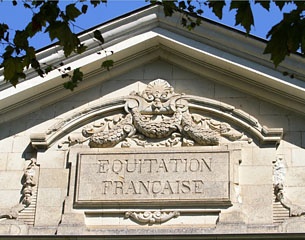
France is repeatedly in the centre of the equestrian community; primarily because it was just recently hosting the World Equestrian Games, but also because a big seminar on the country's traditional equitation will take place in mid October at the National Riding School (ENE) in Saumur. It's an opportunity to look at equestrian traditions in this cultural country. Even though most will associate France with successful showjumpers and eventers rather than dressage riders, it's here that classical principles have their common roots. Let's go on a “Tour de France” to find out more about “Dressage à la Française.”
Nowadays it seems that dressage is split into two approaches: one arising from classical principles, more or less strictly applied, and one which is often called “modern dressage” and focuses on techniques that work the horse in a Low-Deep-Round frame.
As dressage has evolved over the past few decades it seems forgotten that competitive dressage has its historical roots in two different styles: the Germanic and the French (Romanic) school. Whereas the German approach consisted of what we would now think of classical techniques, the French school seems to have widely disappeared and drifted into spheres outside the competition arena where dressage is practised as an art. What remains of the French approach? And what is it? Eurodressage's Silke Rottermann decided to find out:
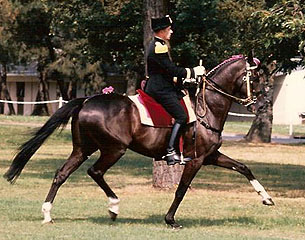 A UNESCO World Heritage since 2011
A UNESCO World Heritage since 2011
In 2011, the news was released that “Equitation in the French tradition” has been added to the UNESCO Intangible Heritage Representative List. UNESCO stated that “the classical French Equitation aims for a harmonious relationship between horse and rider, with mutual respect and lightness.” The attentive reader might well ask two questions then: don’t all kinds of equitation, whether traditional German, Spanish, Californian, aim for these goals? And if that’s the case, what exactly is classical French equitation?
The questions may be simple but the answers are difficult. UNESCO identifies the Cadre Noir in Saumur as the most famous institution where classical French Equitation is supposed to be practised. Each kind of traditional equitation has principles and techniques that make it unique leading to a style that is distinctive, even though the final outcome might be something similar. In order to discover what UNESCO has been preserving for more than three years we need identify what traditional French equitation is and whether this protection status automatically means that it is in danger of “dying out”.
The French Roots of Classical Equitation: De la Guérinière
Even though classical French equitation might be a term that many riders today wouldn’t be able to define, there is one name that’s still known worldwide even though the man himself lived centuries ago: Francois Robichon de la Guérinière (1688-1751). He is renowned as the author of the first holistic and systematic riding manual, “Ecole de cavalerie” (published in 1733) which is still in print in several languages all over the world. De la Guérinière is also regarded as the “inventor” of dressage's universal remedy “shoulder-in” and the modern dressage seat. His dressage training principles were the common basis of all academic schools in Europe, but it would be exaggerated to claim that this meant that he established a common style throughout the continent.
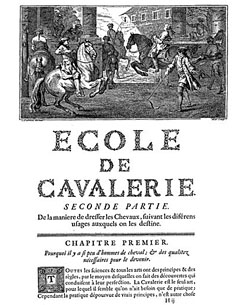 De la Guérinière's manual was rather the basis from which different styles evolved. They were also adjusted by and inevitably reflected the mentality of different nationalities and the horses on which they rode. While the Spanish Riding School in Vienna unyieldingly cherished de la Guérinière's work as the foundation of their style, despite centuries of change and upheaval (his techniques are still the core of the work practiced at the SRS), Germany interpreted it according to its “Prussian mentality” and the heavier horses they had to work with in the 19th and at the beginning of the 20th century. Their rather strict and highly disciplined way of breaking down resistances in a horse was well suited to their horses whereas the French preferred riding Anglo-Arabs and thoroughbreds which would probably not have blossomed with the German approach. France on the other hand, de la Guérinière's native country, was exposed more than any other European country to the many different ideas and convictions their rich equestrian history produced.
De la Guérinière's manual was rather the basis from which different styles evolved. They were also adjusted by and inevitably reflected the mentality of different nationalities and the horses on which they rode. While the Spanish Riding School in Vienna unyieldingly cherished de la Guérinière's work as the foundation of their style, despite centuries of change and upheaval (his techniques are still the core of the work practiced at the SRS), Germany interpreted it according to its “Prussian mentality” and the heavier horses they had to work with in the 19th and at the beginning of the 20th century. Their rather strict and highly disciplined way of breaking down resistances in a horse was well suited to their horses whereas the French preferred riding Anglo-Arabs and thoroughbreds which would probably not have blossomed with the German approach. France on the other hand, de la Guérinière's native country, was exposed more than any other European country to the many different ideas and convictions their rich equestrian history produced.
French Equitation: A Uniform Approach?
So defining classical French equitation is easier said than done, because, compared with the German classical tradition, it developed less systematically. The birth place of French dressage can be found at a venue that still attracts millions of tourists of all over the world: the magnificent Palace of Versailles just outside Paris. Here, during the Renaissance and inspired by the Italian riding-masters, a school was founded that saw a level of equitation never previously achieved. Most notably influenced by Salmon de la Broue (1530-1610), Pluvinel (1555-1620) and their students, riding-masters schooled the best bred Iberian horses with only one aim in mind: producing the most complete art of High School riding. Reports from eye-witnesses and the stylized paintings of the time confirm that one could actually speak of riding as an art. Unfortunately the influence of School of Versailles was not felt in Vienna, which also began to blossom around at that time. Destroyed during the French Revolution, the Versailles School re-opened in 1815, only to close its glorious doors forever in 1830. The fame and brilliance of Versailles was to no real avail for the French equestrian tradition as none of its riding-masters left any publications which could have been used to continue the methods the French had taken at Versailles.
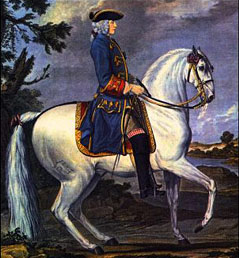 About the time Versailles began to be only a fond memory, more than 300 km south-west of it, the town of Saumur opened the doors of the newly-founded cavalry school. But even if some consider this place on the Loire to be the cradle of French equitation one is not allowed to forget that it was never intended to foster academic equitation in first place, but rather to produce cavalrymen and their horses for battle. Under the influence of military riding and its requirements there was a degree of stagnation compared to the brilliance once produced in Versailles. But this was understandable as High School riding was not the focus of the training the officers received. Even though within the cavalry school some brilliant chief riders highly influential, they were genius individualists who stamped France's equitation at their time, rather than building on the traditions of their predecessors. This meant that for decades after its foundation in 1814 the cavalry school in Saumur follow an individual’s convictions rather than a set of uniform and established methods. For example, Comte d'Aure, himself a product of the School of Versailles, encouraged his students to school their horses in High School using any method they had learned. D’Aure was one of two men whose contrasting styles led to the first real doctrine of the Cadre Noir and French equitation: d'Aure was a proponent of a natural forward-riding style, while François Baucher introduced revolutionary dressage methods based on completely new principles and the artificial movements of circus horses.
About the time Versailles began to be only a fond memory, more than 300 km south-west of it, the town of Saumur opened the doors of the newly-founded cavalry school. But even if some consider this place on the Loire to be the cradle of French equitation one is not allowed to forget that it was never intended to foster academic equitation in first place, but rather to produce cavalrymen and their horses for battle. Under the influence of military riding and its requirements there was a degree of stagnation compared to the brilliance once produced in Versailles. But this was understandable as High School riding was not the focus of the training the officers received. Even though within the cavalry school some brilliant chief riders highly influential, they were genius individualists who stamped France's equitation at their time, rather than building on the traditions of their predecessors. This meant that for decades after its foundation in 1814 the cavalry school in Saumur follow an individual’s convictions rather than a set of uniform and established methods. For example, Comte d'Aure, himself a product of the School of Versailles, encouraged his students to school their horses in High School using any method they had learned. D’Aure was one of two men whose contrasting styles led to the first real doctrine of the Cadre Noir and French equitation: d'Aure was a proponent of a natural forward-riding style, while François Baucher introduced revolutionary dressage methods based on completely new principles and the artificial movements of circus horses.
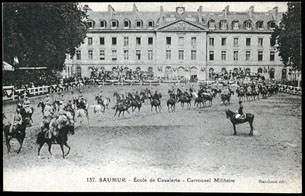 General Alexis L'Hotte (1825-1904) was the Cadre Noir's chief-rider from 1864-1870 and he combined d’Aure and Baucher’s opposing methods. The Cadre Noir still considers L'Hotte's book “Questions Équestres” (published 1906) its blueprint. His famous advice “Calme, en avant, droit” [‘Stay calm, move forwards, straight] summarizes it: working the horse in an atmosphere of mutual trust and respect, in a way that it shows the desire to go forwards all the time and straighten its natural crookedness. L'Hotte’s main priority was to combine impulsion with flexibility so that the end result was a horse moving forwards with lightness.
General Alexis L'Hotte (1825-1904) was the Cadre Noir's chief-rider from 1864-1870 and he combined d’Aure and Baucher’s opposing methods. The Cadre Noir still considers L'Hotte's book “Questions Équestres” (published 1906) its blueprint. His famous advice “Calme, en avant, droit” [‘Stay calm, move forwards, straight] summarizes it: working the horse in an atmosphere of mutual trust and respect, in a way that it shows the desire to go forwards all the time and straighten its natural crookedness. L'Hotte’s main priority was to combine impulsion with flexibility so that the end result was a horse moving forwards with lightness.
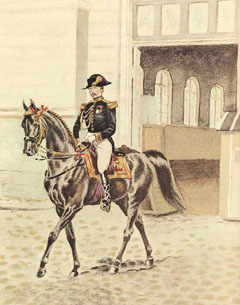 However, the first person to unite successfully the contrasting French approaches whilst developing their practicability within the sport was General Albert-Eugène-Édouard Decarpentry (1878-1956). A very skilled rider, Decarpentry was a multiple Olympic dressage judge and had co-written the first FEI dressage rule book in 1929 before he published his reference-book “Academic Equitation” exactly 20 years later. In this manual Decarpentry synthesised the best of the methods of L'Hotte, Baucher and de la Guérinière into a systematic and effective approach which was also totally suitable for ever-growing sport of dressage. Decarpentry developed the rules for competitive dressage with German General von Holzing-Berstett and used them as a reference point for his manual. Decarpentry also used elements of Gustav Steinbrecht's “Gymnasium of the Horse” which is the German “equestrian bible” to this day and whose author was known for his low opinion of 19th century French equitation. Decarpentry integrated several traditional elements of French dressage training, like flexions, hand-work and long-lining into his manual.
However, the first person to unite successfully the contrasting French approaches whilst developing their practicability within the sport was General Albert-Eugène-Édouard Decarpentry (1878-1956). A very skilled rider, Decarpentry was a multiple Olympic dressage judge and had co-written the first FEI dressage rule book in 1929 before he published his reference-book “Academic Equitation” exactly 20 years later. In this manual Decarpentry synthesised the best of the methods of L'Hotte, Baucher and de la Guérinière into a systematic and effective approach which was also totally suitable for ever-growing sport of dressage. Decarpentry developed the rules for competitive dressage with German General von Holzing-Berstett and used them as a reference point for his manual. Decarpentry also used elements of Gustav Steinbrecht's “Gymnasium of the Horse” which is the German “equestrian bible” to this day and whose author was known for his low opinion of 19th century French equitation. Decarpentry integrated several traditional elements of French dressage training, like flexions, hand-work and long-lining into his manual.
Until General L'Hotte wrote “Questions Equestres” it was hard, if not impossible to speak of a uniform French approach to equitation. Decarpentry remarked “that modern French School owes everything to him.” Decarpentry himself went one step further by paying attention to the necessities of competitive riding without neglecting the French tradition. Therefore Decarpentry can be considered as the “father” of the modern “classical French approach”, even though he modestly denied having written a “a corpus of a doctrine,” considering it rather as a “catalogue of procedures.”
Légèreté: A Reference Point Holding Misunderstandings
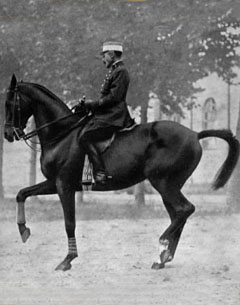 If Decarpentry's book “Academic Equitation” is France's counter-part to Germany's “Gymnasium of the Horse”, the question still remains as to why there is so little general perception of the tradition of French equitation so that UNESCO now protects it. Why are there so many myths and misconceptions regarding it for so long, probably beginning with Baucher more than one hundred years ago? There are two possible reasons. Firstly, as dressage competitions developed from 1950s onwards, people saw the more ‘Germanic’ approach winning the medals. Consequently this approach, supported by excellent trainers, spread world-wide and became regarded as the touchstone against which any other approach must be judged. Secondly, different movements within French equitation, in particular those following Baucher's approach, survived as an art and were very different from those was seen in dressage competitions. The ‘Germanic’ approach held no interest for “Baucheriste” adherents.
If Decarpentry's book “Academic Equitation” is France's counter-part to Germany's “Gymnasium of the Horse”, the question still remains as to why there is so little general perception of the tradition of French equitation so that UNESCO now protects it. Why are there so many myths and misconceptions regarding it for so long, probably beginning with Baucher more than one hundred years ago? There are two possible reasons. Firstly, as dressage competitions developed from 1950s onwards, people saw the more ‘Germanic’ approach winning the medals. Consequently this approach, supported by excellent trainers, spread world-wide and became regarded as the touchstone against which any other approach must be judged. Secondly, different movements within French equitation, in particular those following Baucher's approach, survived as an art and were very different from those was seen in dressage competitions. The ‘Germanic’ approach held no interest for “Baucheriste” adherents.
So for those passionate about equitation, but not coming from France and probably raised with the modern “mainstream” riding approach, it is hard, if not impossible, to see clearly in a supposed jungle of French conceptions. However, a useful reference point for almost all is the term “lightness” (légèreté). Probably the most precise definition of this quality was given by Saumur's Colonel Challan-Belval, who wrote in his book “Dressage” (published 1964): “Lightness is an attitude of the horse which shows in the necessary impulsion, the balance, the suppleness and submissiveness”. An important aspect to this description is given by Commandant St. Fort-Paillard, a multiple French Olympian, saying in his book “Understanding Equitation” that “Lightness should not be considered (…) as a goal at the end of the training. Lightness must be the first ideal that we try to achieve from the beginning of the training. “
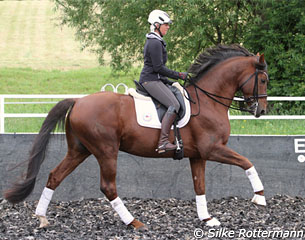 Though lightness is nothing but what should be the aim of any dressage training, whether it is French, German or whatever, there are still many misconceptions about ‘lightness’ as it has sometimes degenerated into a 'trendy' term. Nowadays lightness has become attractive to many riders who are looking for a kind of dressage that is obviously different from what is regularly found in dressage arenas at all levels. What in principle should delight traditionalists and proponents of fine riding has led to several misunderstandings. On the one hand these misunderstandings are based on a non-existent or a superficial knowledge of certain methods and exercises which are less familiar than one's own riding-tradition. The result is that they are regarded suspiciously. This was a problem over a century ago when Baucher's controversial methods with the flexions reached Germany or when French riders were judged by judges influenced by the Germanic School. Equally, a few representatives of French equitation of our days present their methods in ways that do not really clarify things. This is particularly the case if French equitation is presented as a salutary contra-method or is just reduced to specific head-neck-positions.
Though lightness is nothing but what should be the aim of any dressage training, whether it is French, German or whatever, there are still many misconceptions about ‘lightness’ as it has sometimes degenerated into a 'trendy' term. Nowadays lightness has become attractive to many riders who are looking for a kind of dressage that is obviously different from what is regularly found in dressage arenas at all levels. What in principle should delight traditionalists and proponents of fine riding has led to several misunderstandings. On the one hand these misunderstandings are based on a non-existent or a superficial knowledge of certain methods and exercises which are less familiar than one's own riding-tradition. The result is that they are regarded suspiciously. This was a problem over a century ago when Baucher's controversial methods with the flexions reached Germany or when French riders were judged by judges influenced by the Germanic School. Equally, a few representatives of French equitation of our days present their methods in ways that do not really clarify things. This is particularly the case if French equitation is presented as a salutary contra-method or is just reduced to specific head-neck-positions.
There's bad and good riding in every approach and it is unfair to blame an approach for its (too many) bad practitioners, especially if the approach is based on a classical techniques. Whether French or German the goals are the same and the ways to reach them are not as different as they might appear at first. Studying the topic more deeply and with reference to influential manuals of classical riding, will lead to a deeper understanding of how to achieve ‘lightness’: the common goal of every rider who is dedicated to equitation.
Text by Silke Rottermann for Eurodressage.com
References and Reading Recommendations
Colonel Pierre Challan Belval, Dressage-Les principes et leur application, Paris 1964.
Général Decarpentry, Academic Equitation, A Preparation for International Dressage Tests, London 1971, p. 3-13, p. 33-52, p. 63-82.
Général Pierre Durand, Die Prinzipien der französischen Reitkunst (1984), Hildesheim 2006.
Général Pierre Durand, L'Equitation Francaise, Mon choix de coeur et de raison, p. 23 – 73, 2008.
Général Alexis L'Hotte, Questions Équestres, in: Hilda Nelson, Alexis-Francois L'Hotte-The Quest for Lightness in Equitation, London 1997, p.147-215.
Jean-Claude Racinet, Francois Baucher—Entfant Terrible oder Genie?, Hildesheim 2009, p. 47-60, p. 61-76, p. 89-96.
Francois Robichon de la Guérinière, Reitkunst, Hildesheim 2006, p. 146-197.
Jean Saint-Fort Paillard, L'Equitation, Propositions pour comprendre l'equitation, Paris 1975.
Interviews with Colonel Christian Carde 2010-2014.
Related Links